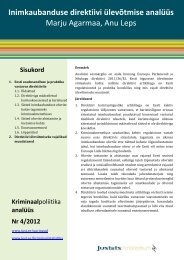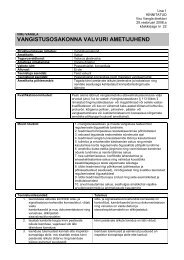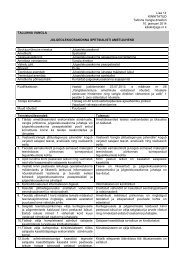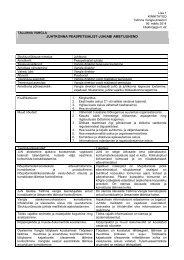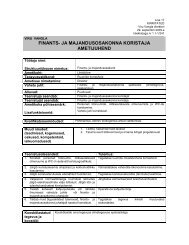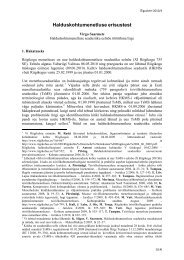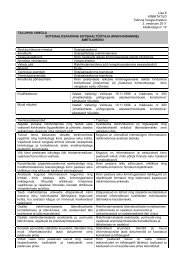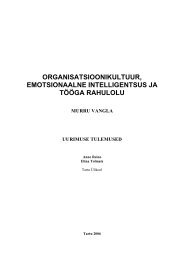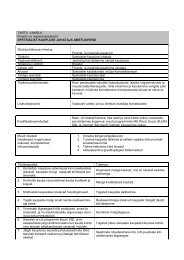11. Retsidiivsus Eestis - Justiitsministeerium
11. Retsidiivsus Eestis - Justiitsministeerium
11. Retsidiivsus Eestis - Justiitsministeerium
Create successful ePaper yourself
Turn your PDF publications into a flip-book with our unique Google optimized e-Paper software.
RETSIDIIVSUS EESTIS 2010<br />
1. RECIDIVISM IN ESTONIA – SUMMARY<br />
RETSIDIIVSUS EESTIS 2010<br />
offences against property, and the lowest in case of serious offences against<br />
the person and sex crimes. In general, Estonian recidivism indicators are in<br />
compliance with these data.<br />
Figure 5. The one-year recidivism rate based on the 2007 database<br />
The recidivism rate is the highest in case of people who have committed theft.<br />
Within a year, from people released from prison a new theft was committed<br />
by 52%, by 33% of committed offenders and 23% of people with respect to<br />
whom proceedings were terminated due to reasons of expediency. It can also<br />
be said based on polls and interviews conducted among bodies conducting<br />
proceedings that bodies conducting proceedings consider the recidivism risk<br />
of people who have committed thefts one of the highest. It was also found<br />
that the commission of thefts is strongly affected by drug addiction and<br />
alcohol dependence.<br />
The opinions of bodies conducting proceedings on recidivism risks did<br />
not coincide with recidivism indicators of people who had committed drugrelated<br />
and sex crimes. Prosecutors and judges found that after thefts, the risk<br />
of committing new criminal offense is higher for people who have committed<br />
namely these criminal offenses, at the same time actual recidivism indicators<br />
are the lowest both in the group of people released from prison and in the<br />
group of convicted offenders. In case of drug-related crimes the assessment<br />
of bodies conducting proceedings of recidivism risk was probably increased<br />
by their apprehension that many drug offenders themselves are addicts which<br />
significantly increases the risk of committing both drug-related crimes and<br />
other criminal offences. From the people imprisoned for both drug-related<br />
and sex crimes only a few people released from prison committed a new criminal<br />
offence of the same type. At the same time, it has to be taken into consideration<br />
that only handling of large quantities of narcotic drugs is regarded as<br />
a drug-related crime; use of drugs is punished pursuant to the misdemeanour<br />
procedure.<br />
Sex crimes were the only crimes from the observed types of criminal<br />
offence where the recidivism rate of convicted offenders exceeded the recidivism<br />
percentage of people released from prison. At the same time, no definite<br />
conclusions can be made based on this indicator because on the one hand,<br />
the number of sex offenders is small, wherefore this indicator is affected by<br />
a specific group of individuals; from the other hand, the recidivism rate of<br />
people released from prison was even higher in 2004 and 2005 (respectively<br />
26% and 38%). Instead both in case of sex offenders and people who have<br />
committed drug-related crimes and driven a car in a state of intoxication it<br />
has to be pointed out that the recidivism rate of these groups in the groups<br />
of people released from prison and of convicted offenders was considerably<br />
more similar than, for example, in case of thefts or crimes of violence, thus<br />
one may assume that in case drunk drivers, drug offenders and people who<br />
have committed sex offences the type of sanction does not have any particular<br />
influence on the commission of new criminal offence, and probably the recidivism<br />
risk of a person who has been imposed pecuniary punishment for driving<br />
in a state of intoxication is not different from, for example, the risk of a person<br />
who has been imposed actual prison sentence. Therefore, one may think that<br />
in case of afore-mentioned criminal offences certain overestimation of recidivism<br />
risk occurs when actual prison sentence is imposed.<br />
As for the recidivism rate, the highest recidivism risk after thefts was<br />
notable in case of people who had committed fraud or robberies. From people<br />
released from prison new criminal offences were committed within a year by<br />
48% people punished for fraud and 44% punished for robberies; the indicators<br />
of convicted offenders were approximately two times lower in this respect.<br />
Surprisingly, in case of those whose proceedings in suspicion of fraud were<br />
terminated due to reasons of expediency, the recidivism rate was higher than<br />
in case of people who had committed thefts, and also higher than the relevant<br />
indicator of convicted offenders. This may refer to the fact that in case of<br />
people who have committed fraud the Prosecutor’s Office underestimates the<br />
recidivism risk by terminating the proceedings too easily.<br />
Prosecutors’ and judges’ opinions on recidivism risk with respect to frauds<br />
and robberies were quite adequate – the risk was considered nearly as high and<br />
at the same time lower than in case of thefts, however, higher than in case of<br />
crimes of violence. In case of robberies the influence of alcohol dependence<br />
and drug addiction increasing the recidivism risk was pointed out.<br />
Judges estimated the recidivism risk of people who had committed crimes<br />
of violence somewhat higher than the prosecutors. Actual recidivism indica-<br />
168<br />
169



